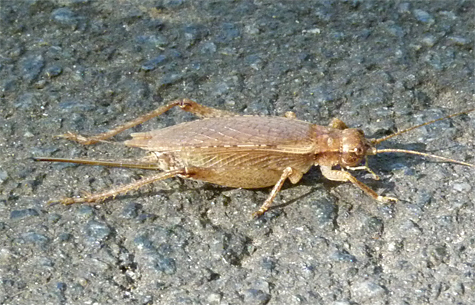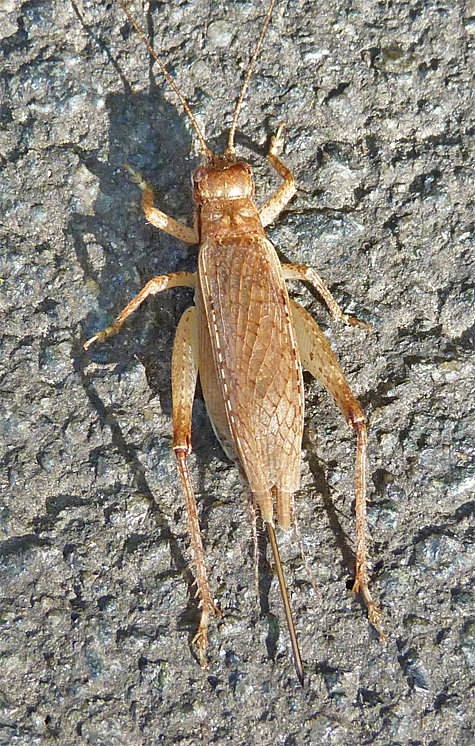
Thursday (10/30), I came upon a cricket on the path in Explore the Wild. I figured it to be a bush or tree cricket but didn’t know which. A quick walk through my handy insect field guide landed me on jumping bush cricket (Orocharis saltator).
Looking a bit deeper into the matter, I came across the false jumping bush cricket (Orocharis luteolira). Further along, in one description of the cricket under the heading of Similar species I found “…no distinguishing morphological features,” referring to the differences between the jumping bush cricket and the false jumping bush cricket. Translation of the previous sentence means that the two crickets look alike, you can’t tell them apart just by looking at them.
Still further along in my reading I see, “chirps shorter (0.15 sec.) with fewer pulses (4-9) and faster pulse rate (71/sec.)” You have to hear the crickets chirping in order to distinguish the two, the false jumping bush cricket having shorter and more rapid chirps. After listening to recordings of the two, I feel confident that I could tell who’s who, that is, if I heard one sing. My cricket was silent.
Both crickets occur in our area, although the jumping, the true jumping, bush cricket is more likely to be seen in “dense lowland woods” and the false cricket in “well-drained, open woodland.” I saw my cricket on a paved path with a wetland on one side and open woods nearby. I would, if pressed, say the habitat was more “lowland” than “well-drained open” in character.

The cricket is obviously a female, it had a long projection sticking out from the rear of the abdomen, an ovipositor. And, her abdomen looked as though it was full. She will probably lay her eggs soon.
It really doesn’t matter which species the cricket is. I suppose it’s not important that I know whether it’s a jumping bush cricket or a false jumping bush cricket. I’ll leave it up to the crickets to sort out the details. All it takes is a few notes of a song for the crickets to know who their dealing with. Come to think of it, that’s all it would take me to distinguish the two, now that I’ve been educated on the matter. Besides, I’m sure the crickets can “smell” each other. They are equipped with very long antennae meant to do just that.
By the way, my source of information about these two closely related Orthopterans was, first, “Field Guide to Insects of North America,” Houghton Mifflin, and then, University of Florida’s SINA website, (Singing Insects of North America). Check it out.
If you want to hear what the two bush crickets sound like, I made it easy for you.